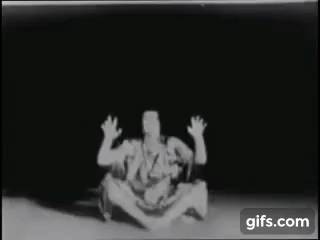
by Jess Henderson
Witch Dance; homage to Mary Wigman
Keywords: free movement, dance, improvisation
Duration: 3-5 minutes
Instructions
Mary Wigman was a radical modern dance pioneer who rejected formalized technique and instead focused on expression of emotion. The use of dance improvisation as a tool for movement development has its roots in her work. So the mythology goes, she suffered terribly from depression and suicidal thoughts until one day she did a ritualistic dance and cured herself.
The elements that define her style include the conviction that dance could be performed without music and that it could have the courage to be ugly.
‘Hexentanz/Witch Dance (1926) is a short solo is a masterpiece of strangeness. Wigman aimed for state of ritualised trance as she danced, summoning up the dangerous spirit of her character, yet the detail and control of her movement is remarkable. The savage crackle of those first hexing gestures; the keening, ducking circle of her upper body and head at 0.20 (made all the more strange by the mask she wears); the slow, spooky opening of her knees at 0.29…’[1]
For this warmup we will loosely follow Wigman’s Hexentanz/Witch Dance:
- Open the Witch Dance video on your computer/iPad/a somewhat larger screen, set it to full screen and put the computer on the ground as you sit on the ground.
- Take three deep breaths and long exhales with eyes closed to ground yourself. Feel your shoulders sink down with each breath as tension is released. Set an intention of what you want to let go of, rid the body of, or conjure during your ritualistic dance.
- Open your eyes and whilst still sitting on the ground, press play on the Witch Dance video and begin following her movements, mimicking the dance as you perform it yourself.
- It’s important to not feel strict or like you are doing it incorrectly – there are no right or wrongs. Allow yourself to follow the movements with the freedom to start improvising for yourself if you feel like it.
- Keep in mind the witchyness of the dance as you perform it. What are you wanting to summon? What are you wanting to expulse?
- At the end of the dance, lay on the ground like a starfish facing upwards and feel the movements you have made through your body. Close your eyes and take three deep inhale/exhales.
- Now you are ready to get to the task at hand.
Option: An option after completing the above instructions is to pick up a pen and notebook and automatically write for three pages, without stopping. Just let flow out in ‘free writing’ style whatever comes to mind.
[1] Mackrell, Judith. "Mary Wigman: a Dance Pioneer with an Awkward Past." The Guardian. Last modified May 22, 2013. https://www.theguardian.com/stage/2013/may/22/mary-wigman-german-modern-dance-pioneer.